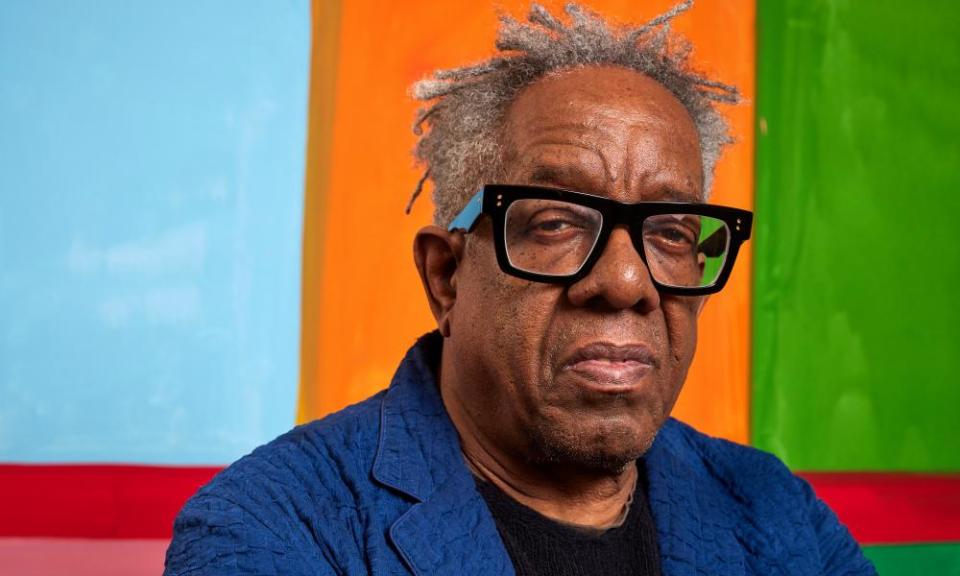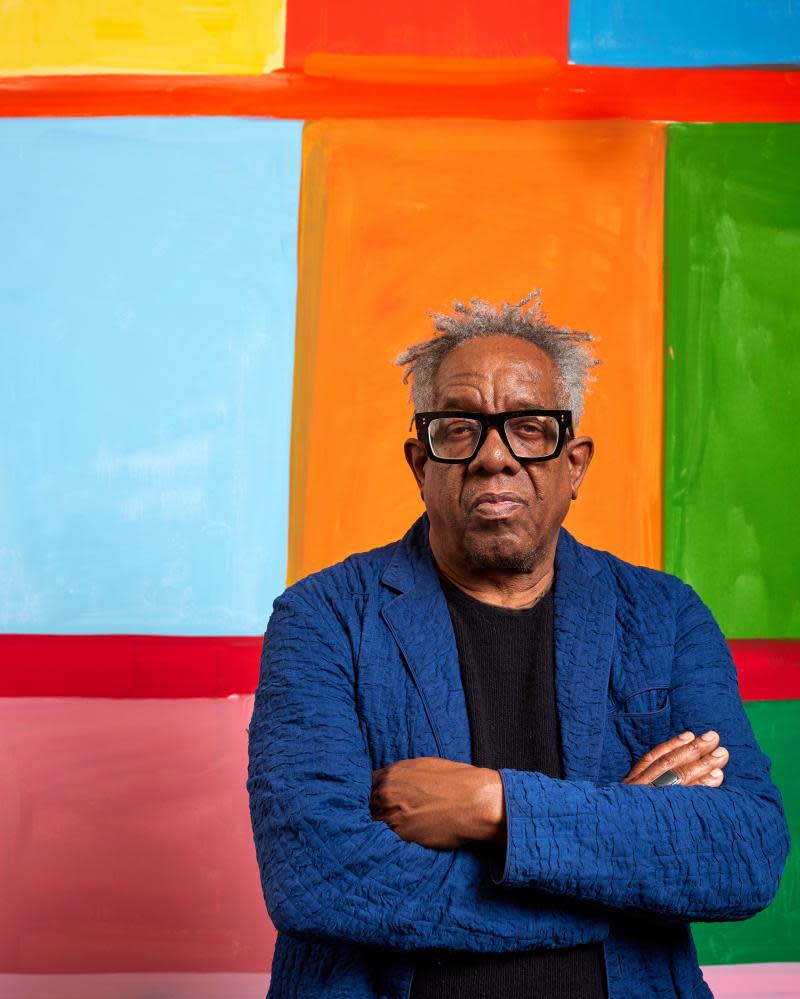‘I’m staying at Larry Gagosian’s place’ – Stanley Whitney’s long journey from rat-infested New York

I’m early, but the gallery receptionist tells me that Stanley will be right down. Right down from where, I wonder. The artist, Stanley Whitney, has an exhibition of new work opening this week at Gagosian in London and will be spending the next couple of months in Paris with his wife Marina Adams, who is also an artist. So, here I am at the gallery’s sleek outpost off the Champs-Élysées. Whitney appears and says, “We’re staying in Larry’s apartment upstairs,” smiling as he hears the words out loud, then laughing at how inconceivable they sound. That’s Larry as in Larry Gagosian, titan of the art world, owner of the international chain of galleries.
The 77-year-old Whitney is the greatest Black abstract artist in America, and his patchwork canvases composed of wobbly blocks of high-key colours are now in great demand. Some works on paper have been on show at the Baltimore Museum of Art since last November, and he’s working towards a major retrospective at the Buffalo AKG Art Museum, due next year. How does it feel to look back over his career? “Awful!” he replies, letting out another laugh, louder this time. “I am excited, but I’m trying to move forward rather than look through old work and wonder why I didn’t keep doing it. I mean, I probably would have if anyone had been interested.” Recognition has been a long time coming.
Whitney grew up in a small African American community outside Philadelphia. Today, he and Adams live and work between Long Island and Parma in Italy; they used to have a place in New York, and Stanley misses city life, hence the spring sojourn in Paris. Art wasn’t a big part of his childhood – “I drew, but I didn’t ever go to a museum, and my parents weren’t interested” – but music was everything, especially jazz. “In high school we would go to New York for the weekend and hang out at the Village Gate and Five Spot listening to Thelonious Monk and Charles Mingus,” he says. “They became my mentors. I was trying to figure out who I was, and their music seemed like me.”

Whitney is friendly and open with a beguilingly rhythmic, slightly husky voice. He’s wearing a cobalt jacket and thick-rimmed rectangular glasses that remind me of his exuberant, chequered paintings. At art school in the midwest he started out making figurative work but soon realised he wasn’t a storyteller. “I wanted to paint everything, and with abstraction, you’re not painting anything in particular, so that seemed possible,” he says.
He spent the summer of 1968 at Skidmore College, where he was befriended by his teacher Philip Guston. “I was moving towards abstraction, and he was moving towards figuration,” says Whitney, gold rings glinting as he gestures with his hands. He credits Guston with teaching him how to put together a painting, and for finally getting him to New York – even if Whitney did drop out of the programme he recommended him for.
There were only a dozen or so Black painters downtown, he tells me, and they didn’t constitute a group. “I knew Robert Rauschenberg and the pop art scene. I knew [art critic] Clement Greenberg’s people, and they were more into jazz and colour, but I didn’t think they drew very well,” Whitney chuckles. “Then there was Donald Judd and that lot who were kind of anti-painting. I didn’t fit in with any of them.”
Whitney took a loft in Tribeca, and a studio in NoHo, and would walk between them looking at all the galleries. “I would say to myself, ‘Well, Stanley, you see what they like, you can do that, or you can keep doing this.” And I thought, I’m going to keep doing this. It was just something I had to paint my way through.”
During the 1970s he completed an MFA at Yale and experimented with different techniques and materials. “In those days, life was cheap, and we felt we had a good five or six years out of school to get going,” he says. Sure, New York was rough: “You walked down the middle of the streets because of the rats.” Still, when he mentions the cost of an arts education today, he says, “I feel a little sad that young artists don’t have much dream time now.”
By the late 1980s, Whitney was making paintings he describes as “interesting”, but: “No matter what I did, I wasn’t getting a break.” The real turning point came in the 90s when he and Adams spent several years in Rome. He had always thought of space and colour as two separate things, but something about the architecture and the light in Italy opened his mind to the possibility that the two could become one. “I had assumed that if I put the colours next to each other, I would shut out the space,” he says. But looking at ancient Roman facades, sarcophagi, murals, he realised the space was in the colour, that he didn’t need gaps in between. “When I understood that, I felt I had the last piece of the puzzle. Space is in the colour – boom, I’ve got it.”
Ever since, Whitney has stuck with the same skewed grid format. He starts every painting in the top left corner and works his way along and down – like a bricklayer, he jokes, but inverted. While he plans the structure, with three or four frieze-like rows of richly hued slabs bordered by loose horizontal bands, the palette is intuitive: “Once I’ve got one colour down, it will tell me what the next colour will be.” He compares it to cooking, when you’re mixing something in a bowl, and you can feel it’s the right consistency. Like the best cooks, he isn’t afraid of improvising, applying his stacks of tangerine, azure blue, dusty pink, lime with different strokes and drizzles, thinly and opaquely. Each canvas has its own vital rhythm – aided, no doubt, by Miles Davis’s Bitches Brew, always playing in the background.
I’m curious to know if he ever feels restricted by the grid, or whether – like Piet Mondrian or Mark Rothko, both big influences – he finds freedom working within self-imposed limits. He describes it as restrictive in a sense, but reminds me that the colours are the opposite, open and free. “It’s a great drama, which is what you want from art,” he says. Looking at his canvases I can feel their energy, as if the brushy blocks of colour are pulsing and jostling, trying to break free. Often the colours are jarring. Occasionally they match the horizontal bands, dissolving the lattice entirely.
The prison-like bars and borders come to life in more overtly political recent works like Always Running From the Police – NYC 2020. “My titles are there to show people who I am, where I come from, what I care about,” Whitney says. “A lot of that has to do with being African American. When I was a kid, I was always running from the police.” I ask if he’s ever felt pressured to make representational work about racial injustice. He tells me he hasn’t, though he has spent a lot of time contemplating his position as a Black abstractionist. He compares the straightforwardly beautiful pictures Matisse made in Nice during the war, with Nazis in the streets, with Picasso’s Guernica. “Is one a better response than the other?” he wonders. “Guernica is a wonderful anti-war painting. There was no love in the world then, and Matisse gave people that.”
Once you hit on a winning formula, it’s hard to deviate from it, but Whitney says that if his paintings ever become ordinary for him, he’ll make a shift. He’s curious to see the exhibition in London. Of course he’s seen the work in the studio, where “everything makes sense”, but in the gallery, he’ll discover how he really feels about it. Whether or not it’s a success isn’t the point, he says, though it remains a welcome change. “I’m still shocked because I painted so long without people noticing me.”
How does he feel about success coming late? “I mean, I grew up poor and could have helped my mother out if I’d had money, and if it had come in my 40s, I would have had more energy,” he says. “Then again, I knew artists who were great who never got anything. And if you’re an artist, you’re going to do the work anyway, whether they think you’re good or bad.” He pauses, presses his lips together. “You know, in life, the big thing is keeping your health. My best friends mostly drank, smoked, made their art and were dead by 50. People are interested in my work now. I can work to my potential. The work is all me. Success came late, but the stars line up when they line up – and if it happens when you’re alive, you’re lucky.”
• Stanley Whitney: There Will Be Song is at Gagosian, Grosvenor Hill, London, 30 March to 13 May.

 Yahoo News
Yahoo News 